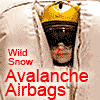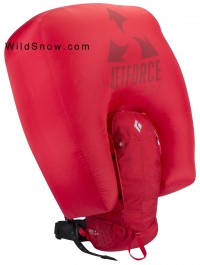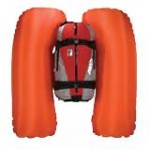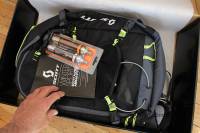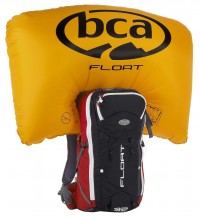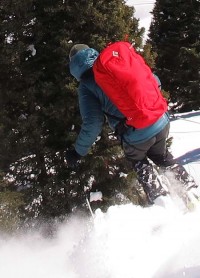2014/2015 Update:
Avalanche airbag backpacks, while effective in terms of safety, are a nightmare in terms of complexity, weight, price and overall consumer challenge. In our opinion here at WildSnow.com the winners of the airbag war will be companies who provide three qualities 1) the lightest packs, 2) easy air travel. 3) easy consumer refills. Keeping the price at or under $1,000 is important as well, but the pack that wins the other challenges will be worth a premium cost. When these qualities all conspire in one backpack it will easily outsell all others combined. For now there is no one uber-backpack — though we are closing in on the singularity. Believe, when the uberpack rises, we’ll be the first ones to shout about it.
In terms of reasonable price and nicely light weight BCA continues as a sweet spot for North American (and often European) shoppers with six models running a gamut of colors, sizes, and user targets. (Note: on the North American side, WARY has shuttered their airbag pack business, and Mystery Ranch is discontinuing all their ski packs until they launch a new ski/ride specific line for 2016/2017.)
Big news is of course the Black Diamond Jetforce electric fan pack. Also new for 2014/2015, we like the Alpride system as it appears to solve some of the user convenience problems by using small airline compatible throw-away gas cylinders you replace with off-the-shelf retail blister packed cylinders. Jetforce is heavy but yields multiple inflations using a rechargeable battery. Alpride is light, simple, and could be the most airline compatible of all gas fired packs.
The other big player in the house is Mammut, who acquired the Snowpulse brand some time ago. The Snowpulse and Mammut packs are somewhat confusing, as they’ve aligned the Snowpulse packs with snowmobiling, and are offering two different airbag shapes/systems (RAS and PAS). One of our gripes with the avalanche airbag backpack industry is we feel it’s all become way too complicated, PAS, RAS… BS? More on that below.
ABS makes nicely designed airbag backpacks as well, but in our opinion their explosive trigger mechanism and nitrogen filled canister (“activation unit”) have become outdated, so we don’t recommend their packs. While shopping, know that quite a few other companies, among them North Face, Osprey, Ortovox and Dakine, use the ABS system in their packs. So, perhaps we’re wrong and a gunpowder charge in your shoulder strap is very 2015? Time will tell.
Avalanche safety can get technical and scientific, but in the end it boils down to human nature. Skiers will ski avalanche slopes, and some of us will ignore, forget, or perhaps never learn how to play that game with reasonable safety. Thus, we need a backup plan. Beacons, having achieved an almost supernatural status in the pantheon of avalanche safety gear, have proved disappointing in real life. Fact is, if you’re buried in a slide you stand a pretty good chance of being dug up dead, no matter how many extra features yours or your partner’s beacon has. Thus, two approaches to this problem. 1.Provide air to the otherwise suffocating buried victim. 2.Prevent burial in the first place.
The former approach is addressed by the Black Diamond Avalung. We like the idea of the ‘Lung, but even more, we like the idea of not being buried in the first place. Thus, again, we’re advocating airbag backpacks. (Note, snow suffocation in tree wells is a very real danger in certain snow climates, and the Avalung a viable solution, so keep that in mind and don’t think the airbag will always be the trump card.)
What about using both Avalung and airbag? It’s easy to ziptie an Avalung to the strap of your airbag backpack. However, we feel that doing so is a overly complex and excessive application of safety gear. At the least, how much fumbling around are you going to do in the split second when the snow fractures under your feet? Ask those who’ve had real experience. In many if not most cases of a skier triggered slab avalanche, you’re not going to have time to fiddle around with both getting an Avalung in your mouth as well as finding and pulling the ripcord on your airbag.
Thus, our advice. If (due to cost, weight, or personal preference) you’re not using an airbag backpack for backcountry skiing in avalanche terrain, by all means rock that Avalung — especially if you’re at risk of treewell suffocation. Otherwise, skip a year of costly mountain bike upgrades and acquire a late model airbag backpack from any of the brands below, practice using it, and don’t be afraid to pull the trigger.
*************************************************
Below is our WildSnow.com overview of the various avalanche airbag systems. While shopping for or researching airbag backpacks, also see our category listing. If you’re wondering what these things are and how they work, see this older post covering whether or not to use an airbag. While etail shopping for airbags can be a good bet for the technical type person, it might be better to work with a brick-and-mortar retailer. SIMPLIFY YOUR SHOPPING: Know that all airbags on the market conform to European CE standards for avalanche airbag backpacks, and are quite similar in performance. Claims about larger balloon volumes and trauma protection are mostly just marketing story; what you’re after is technology that keeps you from getting buried in the white tomb, and does so at the least cost and weight (with a nod to convenience of refills and air travel.)
ABS
ABS started the commercial avalanche airbag game back in 1985, they’ve had years to perfect their system. In fact, most of the published statistics available for air bags are from accidents and tests using the ABS system and are a result of their pioneering efforts. Early versions of their packs used a mono bag system (similar to the system used by BCA), but they moved to a dual airbag in 1996 to create more surface area to ostensibly enhance the system’s ability to keep you on top of the snow. (As a bonus, having two bags provides some redundancy in case one of the bags or valves is damaged). They argue that their dual bag “wing” design puts an avy victim in a horizontal position and therefore less exposed to the dynamic forces of an avalanche. Could be.
Use
The ABS system differs from the others in that it uses a cartridge filled with nitrogen that is sealed and not user refillable (think of a sealed BB gun cartridge; note Alpride also uses this type of cartridge only smaller). There are no valves or gauges or cables to deal with, you just screw the cartridge into a socket in the backpack. The activation is accomplished with a removable “activation handle” which has an explosive round that, when pulled-triggered, sends a shockwave down the line to pierce the seal of the cartridge, which then inflates the dual bags which come out of either side of the pack like wings. The bags stay out of your way and don’t block your vision or range of motion, giving you more freedom to ski away or swim in the avalanche. When thoughtfully configured with a compatible backpack, A-frame ski carry is possible with the ABS system.
To prevent confusion, know that the ABS system is used to create airbag backpacks from several (if not many) other brands of backpacks (e.g., Ortovox and Osprey). It’s a jungle, and we’ll not try and hack through it here besides saying that if you do find a pack you like that has the ABS system, whatever the brand, it’ll work.
The ABS activation handle is stored out of the way in a pocket on the hipbelt, and when preparing for avy terrain, is attached to the shoulder strap via a quick-link coupler similar to an air hose. Once it is in place, the handle has a velcro strap which can be secured over it to keep it from being accidentally pulled. When ready to ski, adjust the strap so there is room for the handle to be pulled. Pulling the handle is surprisingly easy, even with heavy mitts. Repacking the air bags after an inflation is simple; just fold them up and tuck inside the velcro pouches.
ABS ships their packs with two sets of cartridges and activation handles, so you can perform a test release at home. Typically, you pay a deposit for the second cartridge when you buy the pack, which is then refunded when you send it back after your test. When you need your cartridge refilled, you must mail it to an ABS distributor who then sends it to ABS who will refill and send it back to you. The process is actually pretty quick–the filling is done in British Columbia, and we received ours the day after ABS received it (Reported swap times vary, probably due to vagaries of weather, holidays, and that sort of thing. As with all gas packs we recommend keeping two filled cylinders on hand if you’re an active backcountry skier.)
Air Travel with ABS:
We don’t recommend air travel with an ABS explosive trigger and gas canister. The outcome is too uncertain. Instead, arrange to acquire an activation unit at your destination. Also, if you test fire an ABS before air travel, change your clothing and shower before you leave as the trigger leaves explosive residue on your skin and clothing that could be detected by airport security devices and result in hassles.
Scott Alpride
Scott is a big company with the engineering chops to make just about anything. With the increased popularity of ski touring, they’ve entered the fray of wild snow with a bold move into everything from tech compatible ski boots to yes, airbag backpacks. Alpride is based on non-refillable canisters that are similar to the sealed CO2 canisters you use for everything from air rifles to tire inflators.
In this case, one of the canisters is actually a life preserver (PFD) canister that’s similar or matches that used in airplane and boat inflatable PFDs. The other canister is filled with argon, and again is quite similar to a PFD canister. The idea here is the canisters are not only air travel compatible, but available from retailers as affordable blister-packed pairs that retailers can hang on their display wall. It’s a clean system that when paired with a lightweight backpack can be quite low in mass (Scott claims their plumbing is just about the lightest on the market).
Alpride Use
The trigger handle is stowed in a zippered shoulder strap (left side). A firm pull snaps a pair of spring loaded firing pins in the plumbing, in turn puncturing the factory sealed cylinders. Packing the bag is ultimately easy, though a bit confusing if you try to exactly follow the printed directions. The plumbing comes out in minutes for swap into a different Scott backpack. You can insert new cylinders in mere seconds. You cock (arm) the trigger spring with a screw you insert then remove, a visible indicator on the plumbing shows you if the trigger is armed.
We found the zippered airbag containment slot to be a bit tight for easy packing, just a small amount of increased volume would speed up the process and lower the stress level. But it works. Before beginning the packing process do a final separation of the zipper pull, relocate the pull to the other side of the pack, then zip up the compartment as you stuff the bag. The stuffing instructions are confusing and perhaps overwrought. We followed the general idea without getting too finicky and the bag deployed without issues during all our tests. Key trick, while packing insert the eraser side of a pencil or another benign object in the flapper valve on the plumbing, so the gas in the airbag can easily exit as you pack. Otherwise you’ll find yourself needing three hands.
While the one-use cartridge system of the Alpride has upsides, it’s not cheap to recharge. We did a test buy here in the U.S. and ended up paying $43.48 including shipping and tax for a blister packed cartridge set. With any airbag pack you should deploy occasionally to verify function, in our opinion several times a season if not more, so this cost is not trivial.
Air Travel with Alpride
Said to be flawless in Europe, but questions remain about North America. After reading up on it, my opinion is your best bet is to pack the retail blister packed cartridges in your checked baggage along with a printed version of the life jacket info linked to below in an obvious location, and see what happens. If your cylinders do get confiscated you’ll need to pick up another set at your destination so have a plan. The problem is TSA has conflicting information on their website. (Defunct links removed, 2015, but gist is that one paper says no compressed gas, the other says cylinders for life jackets are allowed.)
Our recommended Alpride model: Backcountry Patrol AP E1 30 Pack
Backcountry Access Float
BCA stirred things up a few years ago when they introduced a U.S. made airbag pack at a significantly lower price than the European competitors. They’ve improved quite a bit since then, demonstrating BCA’s commitment to a fine product. Float packs are clean, light, and nicely priced. We recommend them.
Use
The BCA airbag is activated via a handle connected to a cable attached to a release pin. The air bag comes out of the top of the pack, behind the head, like a pillow. The idea here is that it keeps your head up and provides some protection, yet still allows full field of vision and mobility. The BCA pack is shipped to you with a full cylinder and a refill kit is included–very nice. To get an even easier start, you can order the pack with a second cylinder, then test fire it and ship the spent cylinder back to recoup a deposit.
Refilling:
Do it yourself (see our refill guide below), or take it in to one of the many retailers who are licensed to do the refill for you. BCA has done an exemplary job of going out and training shops to do this and thus their list is continuing to grow.
Refill guide
Air Travel:
Air travel with an empty cylinder in your checked baggage, with the top removed so agents can see inside. Print out the data safety sheet off BCA’s website and enclose with the cylinder. Arrange for fill at your destination. See the refill guide and other airbag posts for more details.
Our recommended BCA pack: Float 32
Black Diamond Jetforce
Probably the most talked about backcountry skiing product of 2014, the BD Jetforce packs use a powerful lithium battery to spin a fan based on model jet technology. The airbag fills fast, and you can fill it multiple times off a single charge (exact number depends on temperature of battery).
In our opinion Jetforce is the future of avalanche airbags and has already been quite disruptive of the industry even though the packs are not yet in retail. Only downside is the Jetforce packs are heavy — around eight pounds for the size we’d ski with. It’s said that a smaller battery could eventually be available, cutting around a pound of weight and only providing one or two fills. Don’t hold your breath on that one but we’d sure like to see it. Repacking procedure is reasonable. Stuff the bag back into the opening, re-insert a metal rod lacing system that’s a bit fiddly but you get used to it. Air travel is a no brainer. You can check or carry-on in operative configuration, though you should of course stow the trigger handle and otherwise disable the system to prevent accidental deployment. Rather than kludge more details here for a product that’s not yet in retail, please see our extensive lead-up coverage.
We recommend the Jetforce varieties available here.
Mammut — Snowpulse
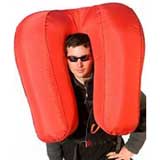
Snowpulse is owned by Mammut, with a trend to the Mammut version packs being designed or skiers and the Snowpulse side focused on snowmobiling. The Snowpulse/Mammut balloons fill with compressed air. The activation handle tucks neatly and conveniently into a zippered pouch–very easy to stow or deploy with a plastic handle that flips open. The handle is attached to a cable which mechanically releases air from the cylinder into the airbag. Note that Mammut sells two different types of airbag systems. RAS (Removable Airbag System) is focused on being able to easily swap between backpacks. PAS (Protective Airbag System) does a good job of wrapping the airbag behind and beside your head, ostensibly to prevent injury. It reminds me of motorcycle airbags mounted in jacket shoulders and collars. I’m not convinced on how effective this is, but it’s a logical idea as the fly in the ointment with all this is how injurious avalanches are.
Refilling and Repacking Snowpulse:
Do it yourself or keep it simple and exchange filled cylinders with the distributor or retailer. Also, when you buy your pack, some distributors offer the option to ship the cylinder empty to save on the HazMat fee.
2.0 system refill guide
1.0 system refill guide
Air Travel with Snowpulse:
Snowpulse supplies three different types of cylinders, a North American refillable cylinder, a European refillable cylinder, and a European non-refillable cylinder (another example of how confusing these systems are). Sadly, the North American version operates at a lower pressure and thus must use a larger cylinder than the Euro version. For the refillable cylinders, you must empty the cylinder and unscrew the cylinder head for air travel. See the refill guides for more on this. The Euro non-user refillable cylinder (only available in Europe) is certified by the IATA to travel filled so you can fly with it while in Europe, but don’t expect good results for North American air travel.
We recommend the Mammut Light Protection Airbag 3.0 Backpack.
European travel note: While users do continue to report intermittent problems when air traveling within Europe, fact of the matter is IATA regulations specifically allow avalanche airbags as checked or carry-on “with approval of the operator…” the following: “Avalanche rescue backpack, one (1) per passenger, equipped with a pyrotechnic trigger mechanism containing less than 200 mg net of Division 1.4S and less than 250 mg of compressed gas in Division 2.2. The backpack must be packed in such a manner that it cannot be accidentally activated. The airbags within the backpacks must be fitted with pressure relief valves.”
See the IATA document here.
While most of the WildSnow backcountry skiing blog posts are best attributed to a single author, some work well as done by the group.

